flink基础教程
随着大数据技术在各行各业的广泛应用,要求能对海量数据进行实时处理的需求越来越多,同时数据处理的业务逻辑也越来越复杂,传统的批处理方式和早期的流式处理框架也越来越难以在延迟性、吞吐量、容错能力以及使用便捷性等方面满足业务日益苛刻的要求。
在这种形势下,新型流式处理框架Flink通过创造性地把现代大规模并行处理技术应用到流式处理中来,极大地改善了以前的流式处理框架所存在的问题。

一句话:flink是etl的工具。
flink的层次结构:

其中,
windows下flink示例程序的执行 简单介绍了一下flink在windows下如何通过flink-webui运行已经打包完成的示例程序(jar)
从flink-example分析flink组件(1)WordCount batch实战及源码分析讲到DataSet的转换
从flink-example分析flink组件(2)WordCount batch实战及源码分析----flink如何在本地执行的?flink batch批处理如何在本地执行的
从flink-example分析flink组件(3)WordCount 流式实战及源码分析 flink stream流式处理如何在本地执行的?
使用flink Table &Sql api来构建批量和流式应用(1)Table的基本概念介绍了Table的基本概念及使用方法
使用flink Table &Sql api来构建批量和流式应用(2)Table API概述介绍了如何使用Table
使用flink Table &Sql api来构建批量和流式应用(3)Flink Sql 使用 介绍了如何使用sql
flink dataset api使用及原理 介绍了DataSet Api
flink DataStream API使用及原理介绍了DataStream Api
flink中的时间戳如何使用?---Watermark使用及原理 介绍了底层实现的基础Watermark
flink window实例分析 介绍了window的概念及使用原理
Flink中的状态与容错 介绍了State的概念及checkpoint,savepoint的容错机制
flink的特征
最后,给出官网给出的特征作为结束:
1、一切皆为流(All streaming use cases )
- 事件驱动应用(Event-driven Applications)

- 流式 & 批量分析(Stream & Batch Analytics)

- 数据管道&ETL(Data Pipelines & ETL)

2、正确性保证(Guaranteed correctness)
- 唯一状态一致性(Exactly-once state consistency)
- 事件-事件处理(Event-time processing)
- 高超的最近数据处理(Sophisticated late data handling)
3、多层api(Layered APIs)
- 基于流式和批量数据处理的SQL(SQL on Stream & Batch Data)
- 流水数据API & 数据集API(DataStream API & DataSet API)
- 处理函数 (时间 & 状态)(ProcessFunction (Time & State))

4、易用性
- 部署灵活(Flexible deployment)
- 高可用安装(High-availability setup)
- 保存点(Savepoints)
5、可扩展性
- 可扩展架构(Scale-out architecture)
- 大量状态的支持(Support for very large state)
- 增量检查点(Incremental checkpointing)
6、高性能
- 低延迟(Low latency)
- 高吞吐量(High throughput)
- 内存计算(In-Memory computing)
flink架构
1、层级结构

2.工作架构图

一:flink初识
Flink起源于Stratosphere项目,Stratosphere是在2010~2014年由3所地处柏林的大学和欧洲的一些其他的大学共同进行的研究项目,2014年4月Stratosphere的代码被复制并捐赠给了Apache软件基金会,参加这个孵化项目的初始成员是Stratosphere系统的核心开发人员,2014年12月,Flink一跃成为Apache软件基金会的顶级项目。
Flink主页在其顶部展示了该项目的理念:“Apache Flink是为分布式、高性能、随时可用以及准确的流处理应用程序打造的开源流处理框架”
Flink将批处理(即处理有限的静态数据)视作一种特殊的流处理。

DataStream API 流式处理的接口,DataSet API 面相批处理的接口
FlinkML:机器学习 CEP:复杂事件处理 Gelly图计算 针对流式和批处理的Table API
二:flink基本架构
2.1:JobManager 与TaskManager
Flink运行时包含了两种类型的处理器:JobManager处理器,TaskManager处理器

2.2 无界数据流与有界数据流
无界数据流:以特定的顺序获取event,立即处理
有界数据流:处理有界流不需要有序获取,因为可以始终对有界数据集进行排序,有界的处理也称为批处理

三:flink集群搭建







四:flink运行架构
4.1任务提交流程

4.2 任务调度原理

4.3 TaskManager与slots
每一个TaskManager是一个JVM进程,它可能会在独立的线程上执行一个进程或多个subtask。为了控制一个TaskManager能接收多少task,TaskManager通过task slot来进行控制(一个TaskManager至少有一个task slot)
每个task slot 表示TaskManager拥有资源的一个固定大小的子集。假如一个TaskManager有三个slot,那么他将其内存内存分成三份给各个slot。需要注意的是,这里不涉及到CPU的隔离。
Task Slot是静态的概念,是指TaskManager具有的并发执行的能力,可以通过taskmanager.numberOfTaskSlots进行配置,而并行度parallelism是动态概念,即TaskManager运行程序时实际使用的并发能力,可以通过paramllelism.default设置。
例:假设一共有3个TaskManager,每个TaskManager中分配3个TaskSlot,也就是每个TaskManager可以接收3 个Task,一共9个TaskSlot,如果我们设置parallelism.default=1,即运行程序的并行度为1,9个TaskSlot只用了1个,有8个空闲,因此要设置合适的并行度才可以提高效率。
五:flink DataStream API
六:Time与Window
七:EventTime与Window
Checkpoint 源码流程:
Flink CheckpointCoordinator 启动流程
先贴段简单的代码

val kafkaSource = new FlinkKafkaConsumer[String]("kafka_offset", new SimpleStringSchema(), prop)
val kafkaSource1 = new FlinkKafkaConsumer[String]("kafka_offset", new SimpleStringSchema(), prop)
val kafkaProducer = new FlinkKafkaProducer[String]("kafka_offset_out", new SimpleStringSchema(), prop)
val source = env
.addSource(kafkaSource)
.setParallelism(1)
.name("source")
val source1 = env
.addSource(kafkaSource1)
.setParallelism(1)
.name("source1")
source.union(source1)
.map(node => {
node.toString + ",flinkx"
})
.addSink(kafkaProducer)

很简单,就是读Kafka,再写回kafka,主要是Checkpoint 的流程,代码在这里就不重要了
-------------------------------------------
一个简化的 Checkpoint 流图
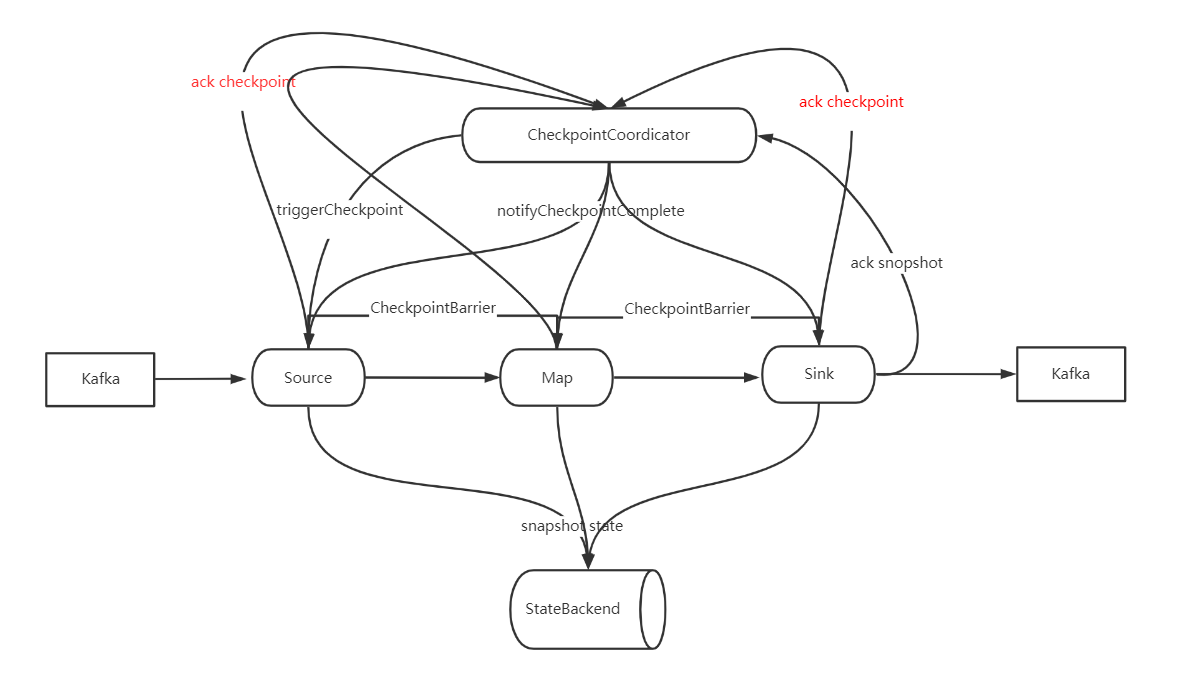
1、CheckpointCoordicator tirgger checkpoint 到 source
2、Source
1、生成并广播 CheckpointBarrier
2、Snapshot state(完成后 ack Checkpoint 到 CheckpointCoordicator)
3、Map
1、接收到 CheckpointBarrier
2、广播 CheckpointBarrier
3、Snapshot state(完成后 ack Checkpoint 到 CheckpointCoordicator)
4、Sink
1、接收到 CheckpointBarrier
2、Snapshot state(完成后 ack Checkpoint 到 CheckpointCoordicator)
5、CheckpointCoordicator 接收到 所有 ack
1、给所有算子发 notifyCheckpointComplete
6、Source、Map、Sink 收到 notifyCheckpointComplete
从流程图上可以看出,Checkpoint 由 CheckpointCoordinator 发起、确认,通过Rpc 通知 Taskmanager 的具体算子完成 Checkpoint 操作。
Checkpoint Timer 启动
Flink Checkpoint 是由 CheckpointCoordinator 协调启动,有个内部类来做这个事情

private final class ScheduledTrigger implements Runnable {
@Override
public void run() {
try {
triggerCheckpoint(true);
}
catch (Exception e) {
LOG.error("Exception while triggering checkpoint for job {}.", job, e);
}
}
}

JobMaster.java 启动 Checkpoint 的 timer

private void startScheduling() {
checkState(jobStatusListener == null);
// register self as job status change listener
jobStatusListener = new JobManagerJobStatusListener();
schedulerNG.registerJobStatusListener(jobStatusListener);
// 这个会调用到 CheckpointCoordinator.scheduleTriggerWithDelay 方法启动第一次 Checkpoint,后续就由 CheckpointCoordinator 自己启动
schedulerNG.startScheduling();
}

ScheduledTrigger 由 Timer 定时调用

private ScheduledFuture<?> scheduleTriggerWithDelay(long initDelay) {
return timer.scheduleAtFixedRate(
new ScheduledTrigger(),
initDelay, baseInterval, TimeUnit.MILLISECONDS);
}
/**
* Executes the given command periodically. The first execution is started after the
* {@code initialDelay}, the second execution is started after {@code initialDelay + period},
* the third after {@code initialDelay + 2*period} and so on.
* The task is executed until either an execution fails, or the returned {@link ScheduledFuture}
* is cancelled.
*
* @param command the task to be executed periodically
* @param initialDelay the time from now until the first execution is triggered 第一次启动 Checkpoint 时间
* @param period the time after which the next execution is triggered 后续的时间间隔
* @param unit the time unit of the delay and period parameter
* @return a ScheduledFuture representing the periodic task. This future never completes
* unless an execution of the given task fails or if the future is cancelled
*/
ScheduledFuture<?> scheduleAtFixedRate(
Runnable command,
long initialDelay,
long period,
TimeUnit unit);

ScheduledTrigger 开始 checkpoint
ScheduledTrigger.run 方法 调用 triggerCheckpoint 开始执行 checkpoint

public CompletableFuture<CompletedCheckpoint> triggerCheckpoint(boolean isPeriodic) {
return triggerCheckpoint(checkpointProperties, null, isPeriodic, false);
}
@VisibleForTesting
public CompletableFuture<CompletedCheckpoint> triggerCheckpoint(
CheckpointProperties props,
@Nullable String externalSavepointLocation,
boolean isPeriodic,
boolean advanceToEndOfTime) {
CheckpointTriggerRequest request = new CheckpointTriggerRequest(props, externalSavepointLocation, isPeriodic, advanceToEndOfTime);
requestDecider
.chooseRequestToExecute(request, isTriggering, lastCheckpointCompletionRelativeTime)
// 调用 startTriggeringCheckpoint 方法
.ifPresent(this::startTriggeringCheckpoint);
return request.onCompletionPromise;
}
private void startTriggeringCheckpoint(CheckpointTriggerRequest request) {
// 获取 需要触发 Checkpoint 的算子
final Execution[] executions = getTriggerExecutions();
....
// no exception, no discarding, everything is OK
final long checkpointId = checkpoint.getCheckpointId();
snapshotTaskState(
timestamp,
checkpointId,
checkpoint.getCheckpointStorageLocation(),
request.props,
executions,
request.advanceToEndOfTime);
coordinatorsToCheckpoint.forEach((ctx) -> ctx.afterSourceBarrierInjection(checkpointId));
onTriggerSuccess();
............
}
private void snapshotTaskState(
long timestamp,
long checkpointID,
CheckpointStorageLocation checkpointStorageLocation,
CheckpointProperties props,
Execution[] executions,
boolean advanceToEndOfTime) {
// send the messages to the tasks that trigger their checkpoint
// 给每个 Execution (在这里可以理解为每个 Source 算子,因为Checkpoint 是从 Source 开始的) 发送 trigger checkpoint 消息
for (Execution execution: executions) {
if (props.isSynchronous()) {
execution.triggerSynchronousSavepoint(checkpointID, timestamp, checkpointOptions, advanceToEndOfTime);
} else {
execution.triggerCheckpoint(checkpointID, timestamp, checkpointOptions);
}
}
}


Execution.java 的 triggerCheckpoint 方法 调用 triggerCheckpointHelper 方法, 通过 TaskManagerGateway 发送 triggerCheckpoint 的 RPC 请求,
调用 RpcTaskManagerGateway.triggerCheckpoint 方法,然后调用 TaskExecutorGateway 的 triggerCheckpoint 方法(TaskExecutor继承自 TaskExecutorGateway,就到 TaskManager 端了)

private void triggerCheckpointHelper(long checkpointId, long timestamp, CheckpointOptions checkpointOptions, boolean advanceToEndOfEventTime) {
final CheckpointType checkpointType = checkpointOptions.getCheckpointType();
if (advanceToEndOfEventTime && !(checkpointType.isSynchronous() && checkpointType.isSavepoint())) {
throw new IllegalArgumentException("Only synchronous savepoints are allowed to advance the watermark to MAX.");
}
final LogicalSlot slot = assignedResource;
if (slot != null) {
final TaskManagerGateway taskManagerGateway = slot.getTaskManagerGateway();
taskManagerGateway.triggerCheckpoint(attemptId, getVertex().getJobId(), checkpointId, timestamp, checkpointOptions, advanceToEndOfEventTime);
} else {
LOG.debug("The execution has no slot assigned. This indicates that the execution is no longer running.");
}
}

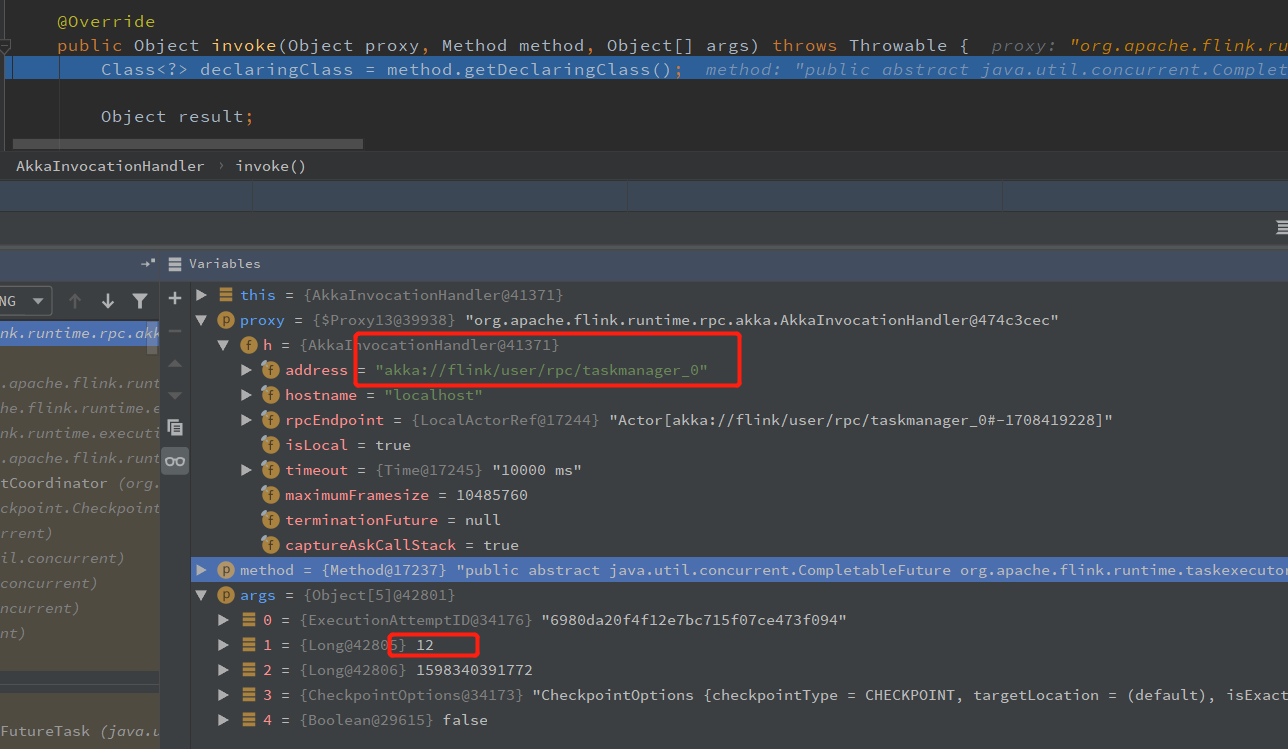
到这里, JobManager 端触发 checkpoint 就完成了,下面就是 TaskManager 端接收 triggerCheckpoint 消息了
TaskManager 接收 triggerCheckpoint 消息
从上面可以知道,JobManager 给 TaskManager 发送 Rpc 请求,调用 RpcTaskManagerGateway.triggerCheckpoint 发送checkpoint 的 Rpc 到 TaskManager,TaskManager 接收到 Rpc 后,会反射到 TaskExecutor 的 triggerCheckpoint 方法,这里就进入 TaskManager 里面了
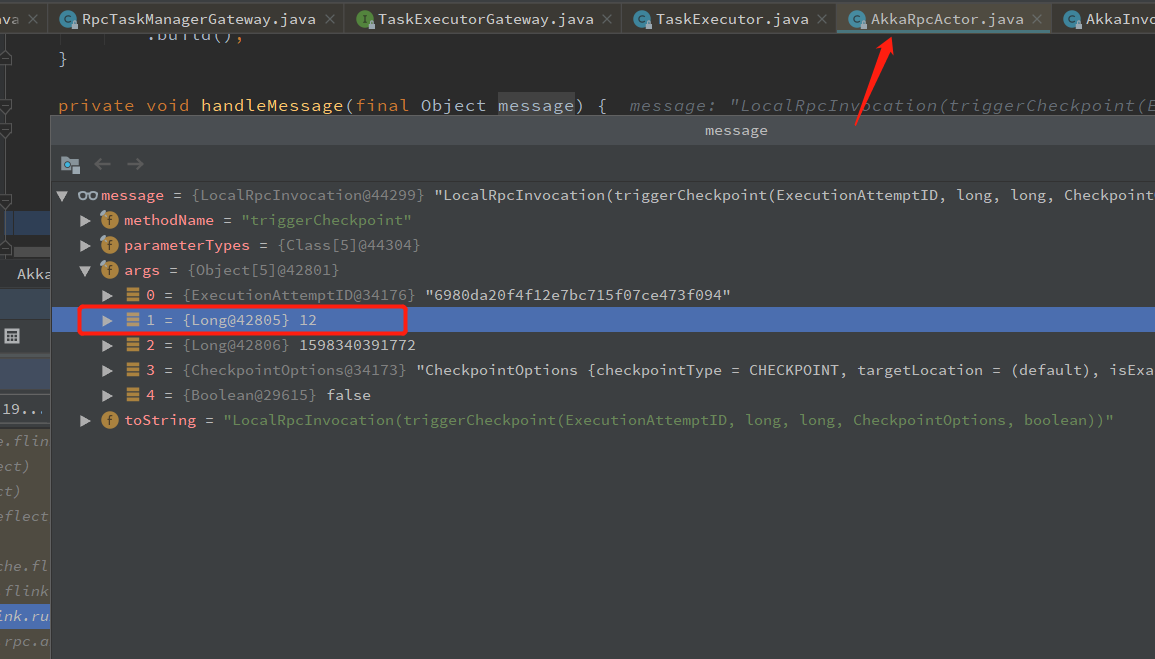

@Override
public CompletableFuture<Acknowledge> triggerCheckpoint(
ExecutionAttemptID executionAttemptID,
long checkpointId,
long checkpointTimestamp,
CheckpointOptions checkpointOptions,
boolean advanceToEndOfEventTime) {
log.debug("Trigger checkpoint {}@{} for {}.", checkpointId, checkpointTimestamp, executionAttemptID); final CheckpointType checkpointType = checkpointOptions.getCheckpointType();
if (advanceToEndOfEventTime && !(checkpointType.isSynchronous() && checkpointType.isSavepoint())) {
throw new IllegalArgumentException("Only synchronous savepoints are allowed to advance the watermark to MAX.");
}
// 使用 operator id 获取 job 对应的 Source 算子 (如果有多个 Source,JobManager 端会发送两个 Rpc 请求,TaskManager 也是执行两次)
final Task task = taskSlotTable.getTask(executionAttemptID); if (task != null) {
// 对 task 触发 一个 Checkpoint Barrier
task.triggerCheckpointBarrier(checkpointId, checkpointTimestamp, checkpointOptions, advanceToEndOfEventTime); return CompletableFuture.completedFuture(Acknowledge.get());
} else {
final String message = "TaskManager received a checkpoint request for unknown task " + executionAttemptID + '.'; log.debug(message);
return FutureUtils.completedExceptionally(new CheckpointException(message, CheckpointFailureReason.TASK_CHECKPOINT_FAILURE));
}
}

Flink Checkpoint 在 TaskManager 端的处理过程是从 Source 开始的,JobManager 会给每个Source 算子发送一个 触发 Checkpoint 的 Rpc 请求,TaskManager 接收到对应 Source 算子的 Checkpoint Rpc 请求后,就开始执行对应流程,同时会往自己的下游算子广播 CheckpointBarrier。
对应 Kafka Source,执行 Checkpoint 的方法 是 FlinkKafkaConsumerBase.snapshotState,Checkpoint 的时候,从 TaskExecutor 到 FlinkKafkaConsumerBase.snapshotState 的调用栈如下,调用栈比较长,就简单列下调用的方法

TaskExecutor.triggerCheckpoint --> task.triggerCheckpointBarrier Task.triggerCheckpointBarrier --> invokable.triggerCheckpointAsync SourceStreamTask.triggerCheckpointAsync --> super.triggerCheckpointAsync StreamTask.triggerCheckpointAsync --> triggerCheckpoint StreamTask.triggerCheckpoint ---> performCheckpoint StreamTask.performCheckpoint --> subtaskCheckpointCoordinator.checkpointState SubtaskCheckpointCoordinatorImpl.checkpointState ---> takeSnapshotSync (会广播 CheckpointBarrier 到下游算子, takeSnapshotSync 成成功后会发送 ack 到 JobMaster) SubtaskCheckpointCoordinatorImpl.takeSnapshotSync ---> buildOperatorSnapshotFutures SubtaskCheckpointCoordinatorImpl.buildOperatorSnapshotFutures ---> checkpointStreamOperator SubtaskCheckpointCoordinatorImpl.checkpointStreamOperator ---> op.snapshotState AbstractStreamOperator.snapshotState ---> stateHandler.snapshotState StreamOperatorStateHandler.snapshotState ---> snapshotState (会调用 operatorStateBackend.snapshot/keyedStateBackend.snapshot 将 state 持久化到 stateBackend ) StreamOperatorStateHandler.snapshotState ---> streamOperator.snapshotState(snapshotContext) AbstractUdfStreamOperator.snapshotState ---> StreamingFunctionUtils.snapshotFunctionState StreamingFunctionUtils.snapshotFunctionState ---> trySnapshotFunctionState StreamingFunctionUtils.trySnapshotFunctionState ---> ((CheckpointedFunction) userFunction).snapshotState (就进入 udf 了,这里是:FlinkKafkaConsumerBase, 如果是自定义的 Source,会进入对应Source 的 snapshotState 方法) FlinkKafkaConsumerBase.snapshotState

Kafka Source Checkpoint
Flink State 可以分为 KeyedState 和 OperatorState,KeyedState 在keyBy 算子之后使用,OperatorState 使用较多的就是存储Source 和 Sink 的状态,比如Kafka Source 存储当前消费的 offset。 其他算子想使用 OperatorState 需要实现 CheckpointedFunction,Operator state 存在 taskManager 的 heap 中,不建议存储大状态。
Kafka Source 的 checkpoint 是在 FlinkKafkaConsumerBase 中实现的,具体方法是: snapshotState
FlinkKafkaConsumerBase 的 checkpoint 流程 大概是,获取 kafkaFetcher 的

/** Accessor for state in the operator state backend. */
// ListState 存储状态,Checkpoint 的时候只需要将 KafkaTopicPartition 和 Offset 放入这个对象中,Checkpoint 的时候,就会写入 statebackend
// Operator state 都是这样的,自己实现的也是,将对应内容写入状态就可以了
private transient ListState<Tuple2<KafkaTopicPartition, Long>> unionOffsetStates; @Override
public final void snapshotState(FunctionSnapshotContext context) throws Exception {
if (!running) {
LOG.debug("snapshotState() called on closed source");
} else {
// 消费者还在运行
// 清楚之前的状态
unionOffsetStates.clear(); final AbstractFetcher<?, ?> fetcher = this.kafkaFetcher;
if (fetcher == null) {
// the fetcher has not yet been initialized, which means we need to return the
// originally restored offsets or the assigned partitions
for (Map.Entry<KafkaTopicPartition, Long> subscribedPartition : subscribedPartitionsToStartOffsets.entrySet()) {
unionOffsetStates.add(Tuple2.of(subscribedPartition.getKey(), subscribedPartition.getValue()));
} if (offsetCommitMode == OffsetCommitMode.ON_CHECKPOINTS) {
// the map cannot be asynchronously updated, because only one checkpoint call can happen
// on this function at a time: either snapshotState() or notifyCheckpointComplete()
pendingOffsetsToCommit.put(context.getCheckpointId(), restoredState);
}
} else {
// 获取对应的 KafkaTopicPartition 和 offset
HashMap<KafkaTopicPartition, Long> currentOffsets = fetcher.snapshotCurrentState();
// 放到 pendingOffsetsToCommit 中
if (offsetCommitMode == OffsetCommitMode.ON_CHECKPOINTS) {
// the map cannot be asynchronously updated, because only one checkpoint call can happen
// on this function at a time: either snapshotState() or notifyCheckpointComplete()
pendingOffsetsToCommit.put(context.getCheckpointId(), currentOffsets);
}
// 将 KafkaTopicPartition 和 offset 写入 operator state 中
for (Map.Entry<KafkaTopicPartition, Long> kafkaTopicPartitionLongEntry : currentOffsets.entrySet()) {
unionOffsetStates.add(
Tuple2.of(kafkaTopicPartitionLongEntry.getKey(), kafkaTopicPartitionLongEntry.getValue()));
}
}
// 移除还未 提交的 offset
if (offsetCommitMode == OffsetCommitMode.ON_CHECKPOINTS) {
// truncate the map of pending offsets to commit, to prevent infinite growth
while (pendingOffsetsToCommit.size() > MAX_NUM_PENDING_CHECKPOINTS) {
pendingOffsetsToCommit.remove(0);
}
}
}
}

当 Checkpoint 完成的时候,会调用到 FlinkKafkaConsumerBase 的 notifyCheckpointComplete 方法,会提交 offset 到 kafka 中,到这里 Kafka Source 的 Checkpoint 就完成了。
fetcher.commitInternalOffsetsToKafka(offsets, offsetCommitCallback);
算子快照完成后会给 JobMaster 发个消息说快照完成了
AsyncCheckpointRunnable.java

private void finishAndReportAsync(Map<OperatorID, OperatorSnapshotFutures> snapshotFutures, CheckpointMetaData metadata, CheckpointMetrics metrics, CheckpointOptions options) {
// we are transferring ownership over snapshotInProgressList for cleanup to the thread, active on submit
// AsyncCheckpointRunnable 的 run 方法,会给 JobMaster 发送 Checkpoint 完成的消息
executorService.execute(new AsyncCheckpointRunnable(
snapshotFutures,
metadata,
metrics,
System.nanoTime(),
taskName,
registerConsumer(),
unregisterConsumer(),
env,
asyncExceptionHandler));
}

AsyncCheckpointRunnable.run

public void run() {
..........
if (asyncCheckpointState.compareAndSet(AsyncCheckpointState.RUNNING, AsyncCheckpointState.COMPLETED)) {
// report ack
reportCompletedSnapshotStates(
jobManagerTaskOperatorSubtaskStates,
localTaskOperatorSubtaskStates,
asyncDurationMillis);
} else {
LOG.debug("{} - asynchronous part of checkpoint {} could not be completed because it was closed before.",
taskName,
checkpointMetaData.getCheckpointId());
}
.........
private void reportCompletedSnapshotStates(
TaskStateSnapshot acknowledgedTaskStateSnapshot,
TaskStateSnapshot localTaskStateSnapshot,
long asyncDurationMillis) {
// we signal stateless tasks by reporting null, so that there are no attempts to assign empty state
// to stateless tasks on restore. This enables simple job modifications that only concern
// stateless without the need to assign them uids to match their (always empty) states.
taskEnvironment.getTaskStateManager().reportTaskStateSnapshots(
checkpointMetaData,
checkpointMetrics,
hasAckState ? acknowledgedTaskStateSnapshot : null,
hasLocalState ? localTaskStateSnapshot : null);
}

一路往下查看,会找到发送 Rpc 消息的地方:
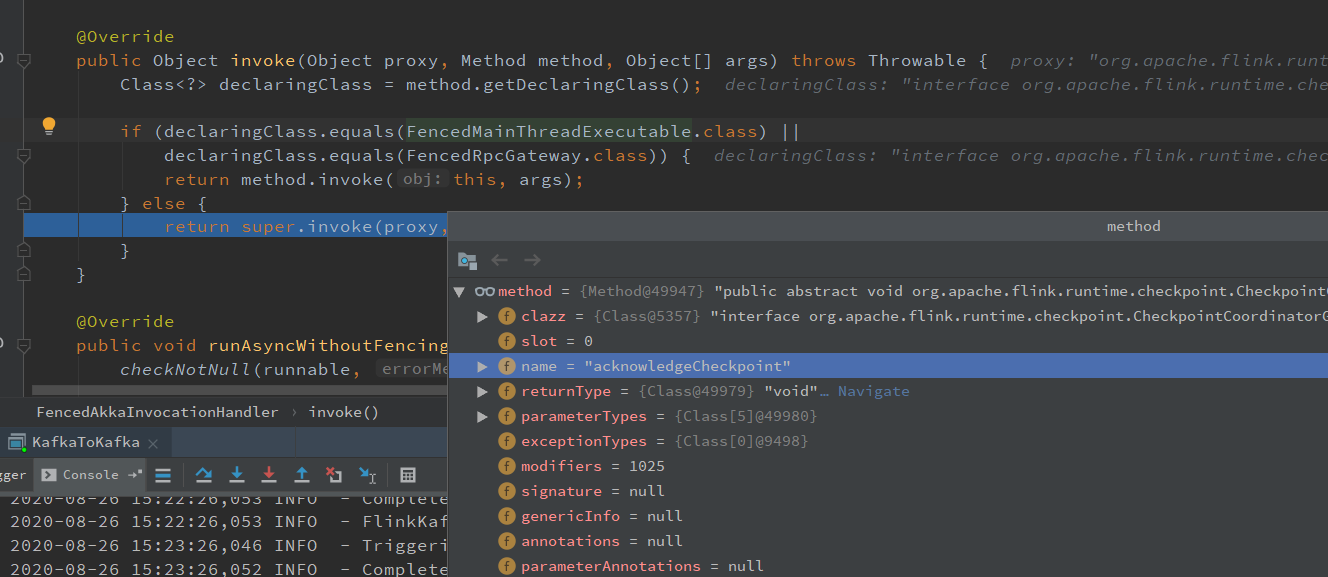
下游算子 map Checkpoint
看 map 的 Checkpoint 流程,直接在 Map 算子上打个断点,看下 调用栈就知道了
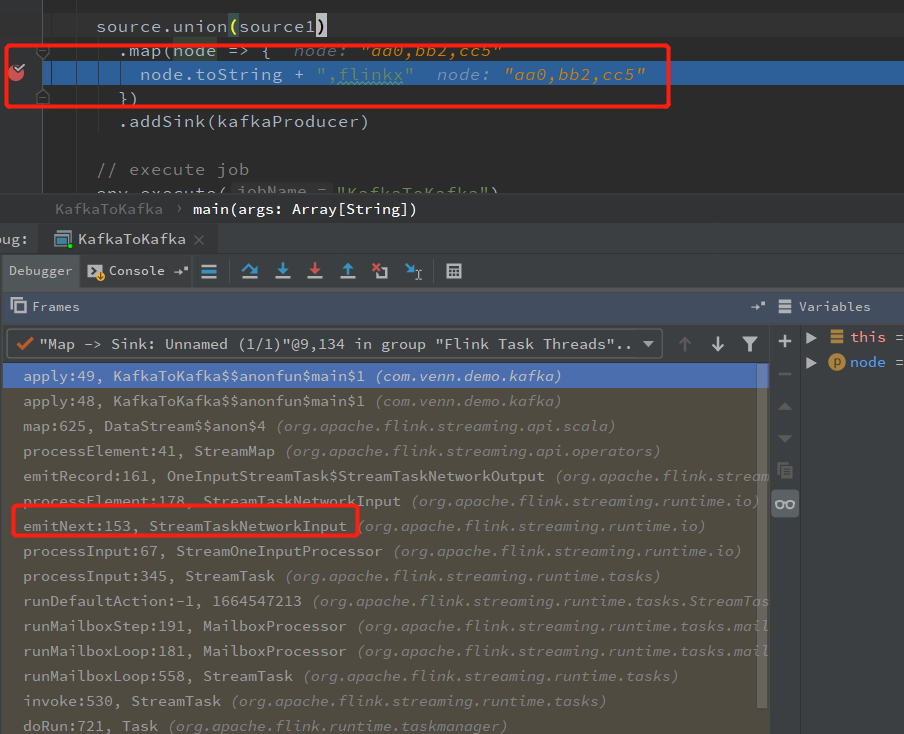
StreamTaskNetworkInput.emitNext 处理输入数据和消息(Checkpoint)
StreamTaskNetworkInput.processElement
OneInputStreamTask.emitRecord
StreamMap.processElement 调用 userFunction.map 就是 我们代码中的map 了
由于 Map 没有状态需要缓存,所以没有实现 CheckpointedFunction,这里只列 出 CheckpointBarrier 广播部分
如果消息是 Checkpoint:
StreamTaskNetworkInput.emitNext

@Override
public InputStatus emitNext(DataOutput<T> output) throws Exception { while (true) {
// get the stream element from the deserializer
if (currentRecordDeserializer != null) {
DeserializationResult result = currentRecordDeserializer.getNextRecord(deserializationDelegate);
if (result.isBufferConsumed()) {
currentRecordDeserializer.getCurrentBuffer().recycleBuffer();
currentRecordDeserializer = null;
} if (result.isFullRecord()) {
// 数据的处理流程,从这里调用直到 user function 的map 中
processElement(deserializationDelegate.getInstance(), output);
return InputStatus.MORE_AVAILABLE;
}
}
// 从 Checkpoint InputGate 读 CheckpointBarrier
Optional<BufferOrEvent> bufferOrEvent = checkpointedInputGate.pollNext();
...
}
}

CheckpointedInputGate.pollNext

@Override
public Optional<BufferOrEvent> pollNext() throws Exception {
while (true) { ....
Optional<BufferOrEvent> next = inputGate.pollNext(); else if (bufferOrEvent.getEvent().getClass() == CheckpointBarrier.class) {
CheckpointBarrier checkpointBarrier = (CheckpointBarrier) bufferOrEvent.getEvent();
// CheckpointBarrier 的处理流程
barrierHandler.processBarrier(checkpointBarrier, bufferOrEvent.getChannelInfo());
return next;
}
...
}
}

barrierHandler.processBarrier 方法中对 Checkpoint 的处理流程跟 FlinkKafkaConsumerBase.snapshotState 调用的流程差不多
从 barrierHandler.processBarrier 调用到 SubtaskCheckpointCoordinatorImpl.checkpointState 往下游广播 CheckpointBarrier
Kafka Sink Checkpoint
Kafka Sink 的 Checkpoint 也是从 Sink 收到 CheckpointBarrier 开始的
接收 CheckpointBarrier 的流程和 Map 一样(所有算子都一样,Source 是生成 CheckpointBarrier 的算子)
之后的流程就和 Source 一样,一路调用到 FlinkKafkaConsumerBase.snapshotState 做快照
与 Kafka Source 一样,Kafka Sink 也是将这次提交的内容放入 ListState 中,Sink 的 Checkpoint 实现了 TwoPhaseCommitSinkFunction(用以实现 精确一次 语义)
FlinkKafkaProducer.java

/**
* State for nextTransactionalIdHint.
*/
private transient ListState<FlinkKafkaProducer.NextTransactionalIdHint> nextTransactionalIdHintState; @Override
public void snapshotState(FunctionSnapshotContext context) throws Exception {
super.snapshotState(context); nextTransactionalIdHintState.clear();
// To avoid duplication only first subtask keeps track of next transactional id hint. Otherwise all of the
// subtasks would write exactly same information.
if (getRuntimeContext().getIndexOfThisSubtask() == 0 && semantic == FlinkKafkaProducer.Semantic.EXACTLY_ONCE) {
checkState(nextTransactionalIdHint != null, "nextTransactionalIdHint must be set for EXACTLY_ONCE");
long nextFreeTransactionalId = nextTransactionalIdHint.nextFreeTransactionalId; // If we scaled up, some (unknown) subtask must have created new transactional ids from scratch. In that
// case we adjust nextFreeTransactionalId by the range of transactionalIds that could be used for this
// scaling up.
if (getRuntimeContext().getNumberOfParallelSubtasks() > nextTransactionalIdHint.lastParallelism) {
nextFreeTransactionalId += getRuntimeContext().getNumberOfParallelSubtasks() * kafkaProducersPoolSize;
}
// 精确一次语义的 Checkpoint 状态
nextTransactionalIdHintState.add(new FlinkKafkaProducer.NextTransactionalIdHint(
getRuntimeContext().getNumberOfParallelSubtasks(),
nextFreeTransactionalId));
}
}

TwoPhaseCommitSinkFunction.java

protected transient ListState<State<TXN, CONTEXT>> state; @Override
public void snapshotState(FunctionSnapshotContext context) throws Exception {
// this is like the pre-commit of a 2-phase-commit transaction
// we are ready to commit and remember the transaction checkState(currentTransactionHolder != null, "bug: no transaction object when performing state snapshot"); long checkpointId = context.getCheckpointId();
LOG.debug("{} - checkpoint {} triggered, flushing transaction '{}'", name(), context.getCheckpointId(), currentTransactionHolder);
// 预提交即调用 producer.flush 提交数据到 Kafka
preCommit(currentTransactionHolder.handle);
pendingCommitTransactions.put(checkpointId, currentTransactionHolder);
LOG.debug("{} - stored pending transactions {}", name(), pendingCommitTransactions);
// 开启事务
currentTransactionHolder = beginTransactionInternal();
LOG.debug("{} - started new transaction '{}'", name(), currentTransactionHolder); state.clear();
// 将 事务信息写入 状态
state.add(new State<>(
this.currentTransactionHolder,
new ArrayList<>(pendingCommitTransactions.values()),
userContext));
}

看到这里,应该都发现了 FlinkkafkaConsumerBase 和 TwoPhaseCommitSinkFunction 都有 notifyCheckpointComplete,在这个方法才真正完成 Checkpoint 往外部数据写入 offset,提交事务。
注: Sink 完成 snaposhot 完成后会给 JobMaster 发送 ack 消息,与 Source 部分相同
JobManager 发送 confirmCheckpoint 消息给 TaskManager
JobManager 接收 checkpoint snapshotState 完成的消息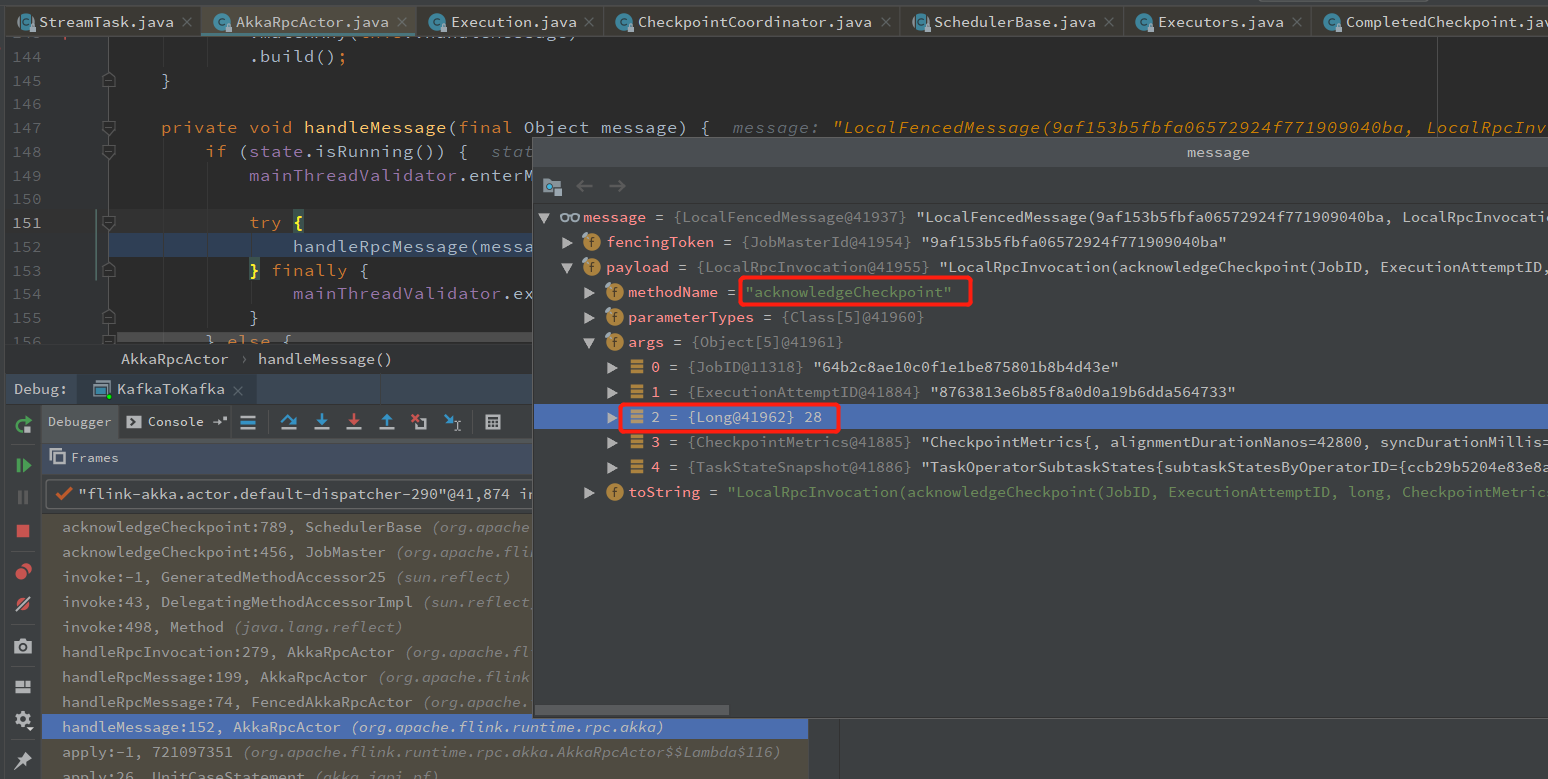
jobmanager接收完成 snapshotState 消息,然后会给 TaskManager 发送 所以算子完成快照的消息,调用算子的 notifyCheckpointComplete 方法,完成 Checkpoint 全部过程。
CheckpointCoordinator.receiveAcknowledgeMessage
CheckpointCoordinator.completePendingCheckpoint
CheckpointCoordinator.sendAcknowledgeMessages

private void sendAcknowledgeMessages(long checkpointId, long timestamp) {
// commit tasks
for (ExecutionVertex ev : tasksToCommitTo) {
Execution ee = ev.getCurrentExecutionAttempt();
if (ee != null) {
ee.notifyCheckpointComplete(checkpointId, timestamp);
}
}
// commit coordinators
for (OperatorCoordinatorCheckpointContext coordinatorContext : coordinatorsToCheckpoint) {
coordinatorContext.checkpointComplete(checkpointId);
}
}

从 ee.notifyCheckpointComplete 进去,可以看到发送 Rpc 消息的地方
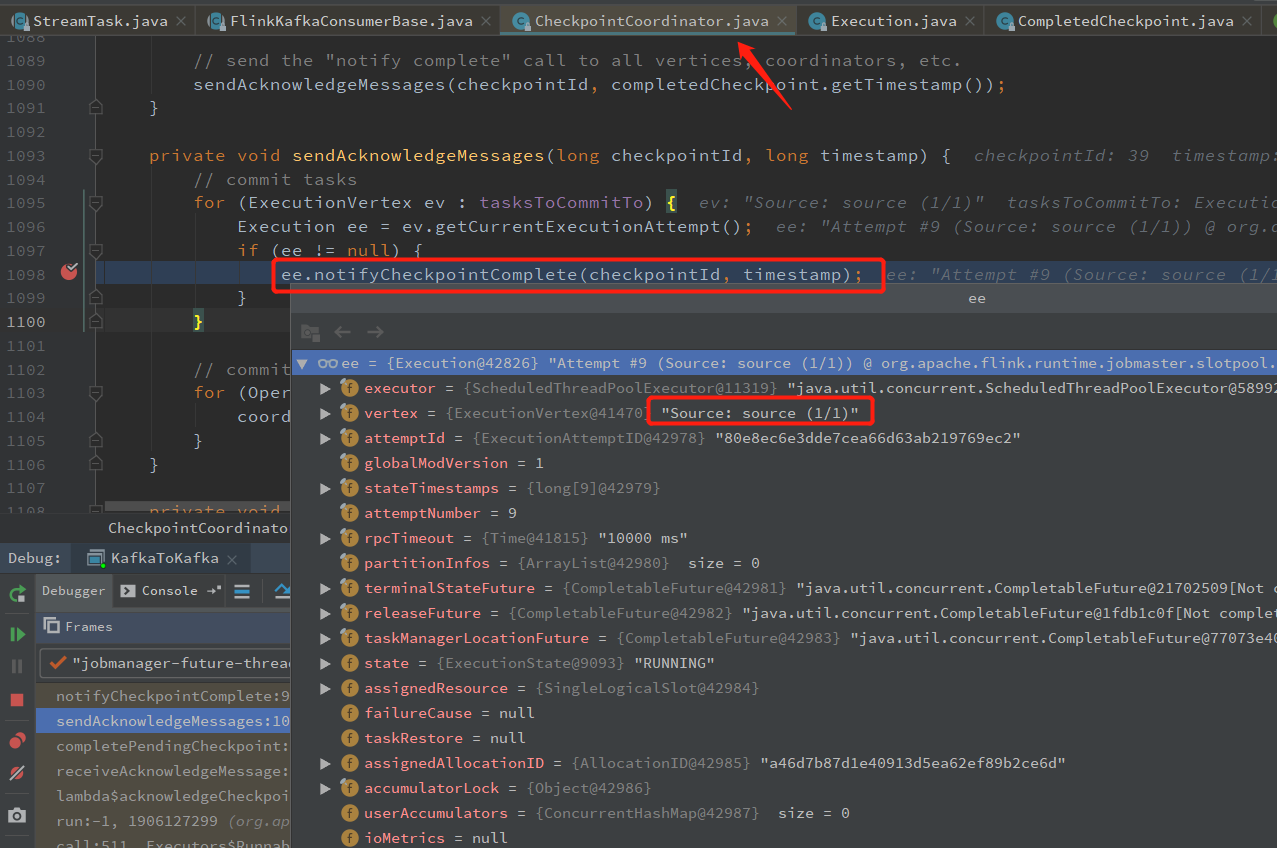
Kafka Source/Sink 接收 notifyCheckpointComplete
对于 Source 从TaskManager 收到 confirmCheckpoint 开始
图片: tm接收confirmCheckpoint消息
一路调用到 FlinkKafkaConsumerBase.notifyCheckpointComplete 提交 offset 到 Kafka
Sink 基本一样,不过 FlinkKafkaProducer 的 notifyCheckpointComplete 在 TwoPhaseCommitSinkFunction 中(继承来的)
里面会调用到 FlinkKafkaProducer.commit 方法,提交 Kafka 事务

@Override
protected void commit(FlinkKafkaProducer.KafkaTransactionState transaction) {
if (transaction.isTransactional()) {
try {
// 调用 KafkaProduce 的方法,提交事务
transaction.producer.commitTransaction();
} finally {
recycleTransactionalProducer(transaction.producer);
}
}
}

至此 Checkpoint的前台流程就全部完成了
flink基础教程的更多相关文章
- flink基础教程读书笔记
数据架构设计领域发生了重大的变化,基于流的处理是变化的核心. 分布式文件系统用来存储不经常更新的数据,他们也是大规模批量计算所以来的数据存储方式. 批处理架构(lambda架构)实现计数的方式:持续摄 ...
- (转)Windows驱动编程基础教程
版权声明 本书是免费电子书. 作者保留一切权利.但在保证本书完整性(包括版权声明.前言.正文内容.后记.以及作者的信息),并不增删.改变其中任何文字内容的前提下,欢迎任何读者 以任何形式(包括 ...
- matlab基础教程——根据Andrew Ng的machine learning整理
matlab基础教程--根据Andrew Ng的machine learning整理 基本运算 算数运算 逻辑运算 格式化输出 小数位全局修改 向量和矩阵运算 矩阵操作 申明一个矩阵或向量 快速建立一 ...
- <<Bootstrap基础教程>> 新书出手,有心栽花花不开,无心插柳柳成荫
并非闲的蛋疼,做技术也经常喜欢蛋疼,纠结于各种技术,各种需求变更,还有一个很苦恼的就是UI总是那么不尽人意.前不久自己开源了自己做了多年的仓储项目(开源地址:https://github.com/he ...
- Memcache教程 Memcache零基础教程
Memcache是什么 Memcache是danga.com的一个项目,来分担数据库的压力. 它可以应对任意多个连接,使用非阻塞的网络IO.由于它的工作机制是在内存中开辟一块空间,然后建立一个Hash ...
- Selenium IDE 基础教程
Selenium IDE 基础教程 1.下载安装 a 在火狐浏览其中搜索附件组件,查找 Selenium IDE b 下载安装,然后重启firefox 2.界面讲解 在菜单- ...
- html快速入门(基础教程+资源推荐)
1.html究竟是什么? 从字面上理解,html是超文本标记语言hyper text mark-up language的首字母缩写,指的是一种通用web页面描述语言,是用来描述我们打开浏览器就能看到的 ...
- 转发-UI基础教程 – 原生App切图的那些事儿
UI基础教程 – 原生App切图的那些事儿 转发:http://www.shejidaren.com/app-ui-cut-and-slice.html 移动APP切图是UI设计必须学会的一项技能,切 ...
- 【Unity3D基础教程】给初学者看的Unity教程(四):通过制作Flappy Bird了解Native 2D中的RigidBody2D和Collider2D
作者:王选易,出处:http://www.cnblogs.com/neverdie/ 欢迎转载,也请保留这段声明.如果你喜欢这篇文章,请点[推荐].谢谢! 引子 在第一篇文章[Unity3D基础教程] ...
- oracle基础教程(8)oracle修改字符集
oracle基础教程(8)oracle修改字符集 1.用dba连接数据库 -->sqlplus / as sysdba 2.查看字符集 -->SELECT parameter, value ...
随机推荐
- 解决DDD最大难题-如何划分领域
本文书接上回<反DDD模式之"复用">,关注公众号(老肖想当外语大佬)获取信息: 最新文章更新: DDD框架源码(.NET.Java双平台): 加群畅聊,建模分析.技术 ...
- IPC-7095E-2024 EN Design and Assembly Process Guidance for Ball Grid Arrays (BGAs). IPC-7095E BGA 设计与组装工艺的实施
IPC-7095E-2024 EN Design and Assembly Process Guidance for Ball Grid Arrays (BGAs).pdf链接: https://pa ...
- python socket检测端口及ping检测
python根据socket模块检测端口及vip #!/usr/bin/env python # -*- coding: utf8 -*- from .ping_helper import Pinge ...
- Mybatis源代码分析之类型转换
ORM框架最重要功能是将面向对象方法中的对象和关系型数据库中的表关联了起来,在关联过程中就必然涉及到对象中的数据类型和数据库中的表字段类型的转换,Mybatis中的org.apache.ibatis. ...
- Java对象内存结构
原文于2008年11月13日 发表, 2008年12月18日更新:这里还有一篇关于Java的Sizeof运算符的实用库的文章. 学C/C++出身的我,对Java有一点非常困惑,那就是缺乏计算对象占用内 ...
- element table 合并同类项并输出后台返回数据
table的样式如下 后台返回的数据格式是按照横着来的,因为表头是经过处理的,而且是作为独立出来的数据返给前端的,所以当我们进行数据填充的时候需要用到后台返回的完整的数据,要想一一对应的话,我们需要进 ...
- Jx.Cms开发笔记(三)-Views主题动态切换
效果展示 我们可以在后台动态切换主题 目前Jx.Cms有两个主题,其中一个是默认主题,另一个是仿的Blogs主题. 我们可以通过点击启用按钮来动态切换两个主题. 实现方法 首先写一个实现IViewLo ...
- 微服务-SpringBoot
基础知识 微服务主旨就是将一个大型系统拆分为多个小型服务. 多个服务之间可以是异构的.单体服务在大型项目下很难维护. 智能端点与哑管道:就是消息之间通信只传送消息,而不做校验. SpringCloud ...
- canvas(五)绘制文本
1.绘制描边文本 说明:描边的属性是共用的,无论是绘制直线还是文字,所以有需要的话要单独设置描边颜色,相关语法如下 语法 说明 ctx.strokeStyle 设置描边的颜色(文本颜色) ctx.fo ...
- 实用干货分享(5)- Hive存储格式及压缩算法测试比对分析
编辑 Hive文件存储格式及优缺点 textfile 默认的文件格式,行存储.建表时不指定存储格式即为textfile,导入数据时把数据文件拷贝至hdfs不进行处理. 优点:最简单的数据格式,便 ...
